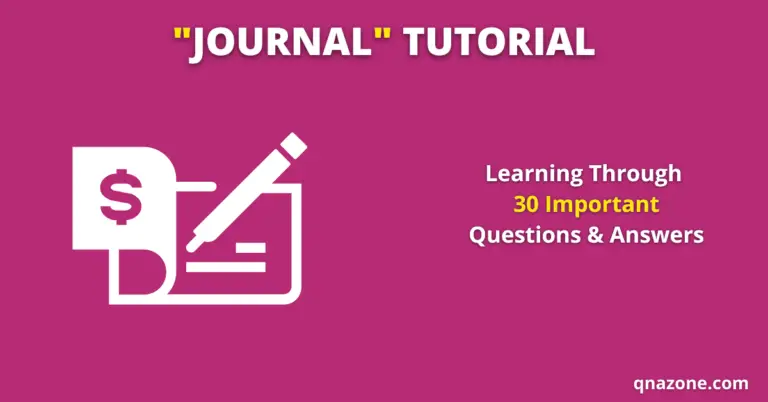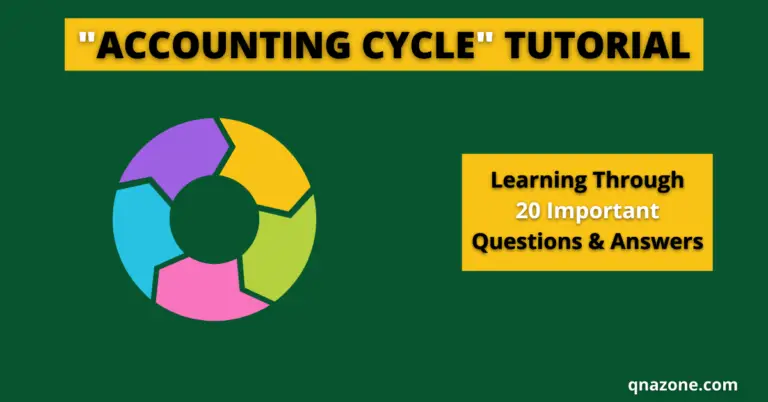45 Important Financial Statement Questions and Answers [With PDF]
The 11th chapter of our accounting learning course is “Financial Statement”. We’ll go over the 45 most important financial statement questions and their answers in this article.
It will assist you in quickly grasping the most important financial statement terms and their explanations.
By reading this post, you can quickly prepare for accounting courses and any competitive tests, such as school and college exams, vivas, job interviews, and so on.
Financial Statement Questions and Answers
The 45 most important financial statement questions and answers are as follows:
Question 01: What is a Financial Statement?
Answer: A financial statement is a structured, disciplined, and continuous process of knowing the financial results and the state of affairs of an organization.
Question 02: What are the five statements that a financial statement contains?
Answer: The five statements that a financial statement contains are as follows:
- The Statement of Comprehensive Income
- The Statement of Changes in Equity
- The Statement of Financial Position
- The Statement of Cash Flows
- The Notes, comprising a summary of significant accounting policies and other explanatory information, are provided in the financial statement.
Question 03: What are the objectives of financial statements?
Answer: The main objectives of financial statements are as follows:
- Providing data to aid in decision-making.
- estimation of future cash flow.
- providing information on profits and business performance.
- providing information on how to obtain funds and how to put them to good use.
Question 04: What is the importance of financial statements?
Answer: The importance of financial statements is as follows:
- Assist in the preparation of the company’s budgets and plans.
- Aid in determining the organization’s ability to repay current and long-term liabilities.
- Assist the loan creditors in making a decision.
- Aid with tax calculations.
- Assist in making a dividend declaration decision.
- Assist in the formulation of government policies on industry, trade, and tariffs.
Question 05: What are the limitations of financial statements?
Answer: The major limitations of financial statements are as follows:
- Unable to provide a true and accurate financial picture.
- Accounts are kept on the basis of historical costs.
- There is a lack of qualitative data.
- Future data is unavailable.
- It is not possible to make a relative comparison.
Question 06: Who are the users of financial statements?
Answer: The users of financial statements are as follows:
Internal users:
- Owners
- Management authority
- Internal auditors
External users:
- Creditors
- Investors
- Potential investors
- Government
- Loan creditors
- Tax authority
- External auditor
- Trade union
Question 07: How do financial statements help their users?
Answer: Financial statements help the users make economic decisions by providing accounting information on financial results, the state of affairs, cash flow, etc.
Question 08: What is the statement of comprehensive income?
Answer: The statement that is prepared to ascertain the profit and loss of the business is known as the Statement of Comprehensive Income.
Question 09: What was the previous name of the statement of comprehensive income?
Answer: The statement of comprehensive income was previously known as the income statement.
Question 10: What kinds of accounts are used to prepare the comprehensive income statement?
Answer: The statement of comprehensive income uses two kinds of accounts:
- Revenue types of income.
- revenue-types of expenditures.
Question 11: What are the objectives of the statement of comprehensive income?
Answer: The two important objectives of the statement of comprehensive income are as follows:
- From a comprehensive income statement, we can easily figure out the net profit and loss.
- By analyzing different income and expenditures on the Statement of Comprehensive Income, we can know how to increase a firm’s net profit by increasing future income and decreasing expenditures.
Question 12: What are the two types of comprehensive income statement preparation?
Answer: The two types of comprehensive income statements are as follows:
- A single-step income statement
- A multiple-step comprehensive income statement
Question 13: What is a single-step income statement?
Answer: A single-step income statement is an income statement that calculates net profit or loss in one step by subtracting the total of all expenses from the total of all income for a given accounting period.
Question 14: What is a multiple-step comprehensive income statement?
Answer: A multiple-step comprehensive income statement is an income statement that calculates the net profit or loss of an organization by separating the various types of income and expenses into different stages.
Question 15: How to prepare a statement of comprehensive income?
Answer: A statement of comprehensive income is prepared mainly in three stages.
- Gross profit can be calculated in the first stage by subtracting the cost of goods sold from sales revenue.
- Operating profit can be calculated in the second stage by adding indirect operating income to gross profit and then subtracting operating expenses from the total.
- In the third stage, net profit is calculated by combining operating profit with net non-operating incomes/expenses (non-operating income – less non-operating expenses).
Question 16: What is the format of the statement of comprehensive income?
Answer: The format of the statement of comprehensive income is as follows:
Question 17: What is an example of operating income?
Answer: The example of operating income is as follows:
- sales of goods and services.
- Discount received.
- Commission received
Question 18: What is an example of non-operating income?
Answer: The example of non-operating income is as follows:
- A profit from the sale of fixed assets
- Interest on investment
- Interest in drawings
- Interest on a loan
- Interest received from the bank
- Apprenticeship premium received
- Rent received from sub-let
- Dividend received
Question 19: What are some examples of operating expenses?
Answer: The examples of operating expenses are as follows:
- Purchases
- Carriage Inward
- Wages
- Import Duty
- Freight
- Dock Charges
- Factory rent &
- Electricity Fuel Charges
- Salaries
- Carriage Outward
- Office rent & Electricity
- Office expenses
- Discount Allowed
- Repairs
- Postage & Telephone
- Advertisement
- Stationery
- Packing Expenses
- Insurance
- Traveling Expenses
- Bad Debt
- Provision for bad and doubtful debts
- Depreciation on assets
- Write-off of Goodwill
Question 20: What are some examples of non-operating expenses?
Answer: The examples of non-operating expenses are as follows:
- loss from the sale of fixed assets
- Commission Paid
- Interest on capital
- Interest on a bank loan
- Interest on the bank overdraft
- Bank charges
- Allowance for Apprenticeship
- Theft or Accidental losses
Question 21: What is an example of a statement of comprehensive income?
Answer: The following example will make the statement of comprehensive income much easier to comprehend.
Prepare the Statement of Comprehensive Income of ABC advertising firm from the information given below for the year ending March 31st, 2022.
- income from services $24,000
- interest received $8,00
- discount Received $1,000
- dividend earnings $2,000
- advertising expenses $7,000
- office rent $3,000
- electricity & telephone bill $1,500
- insurance expenses $2,000
- conveyance $700
- manager’s salary $3,000
- stationary expense $500
Solution: The solution to the above problem is as follows:
ABC Advertising
Statement of Comprehensive Income
For the year ended 31st March 2022
| Particulars | Amount ($) | Amount ($) |
| Income: | | |
| Income from services | 24,000 | |
| Interest received | 800 | |
| Discount received | 1,000 | |
| Dividend earnings | 2,000 | |
| Total Income | | 27,800 |
| Expenses: | | |
| Advertising expense | 7,000 | |
| Office rent | 3,000 | |
| Electricity and Telephone bill | 1,500 | |
| Insurance | 2,000 | |
| Conveyance | 700 | |
| Manager’s salary | 3,000 | |
| Stationary | 500 | |
| Total Expenses | | 17,700 |
| Net Profit | | 10,100 |
Question 22: What is the cost of goods sold?
Answer: The total of the expenses incurred on the goods sold during a period to bring them into saleable condition is called the cost of goods sold.
Cost of goods sold = opening stock + (net purchase + other expenses related to purchasing) – closing stock. Other expenses related to purchasing, such as carriage inward, wages, import duty, etc.
Question 23: What is the provision for doubtful debt?
Answer: The amount of debt that may not be realized is called “doubtful debt,” which is a probable loss and will be included in operating expenses.
Question 24: What is the statement of financial position?
Answer: The statement prepared to ascertain the assets, liabilities, and capital is called a “statement of financial position.”
Question 25: What was the previous name of the statement of financial position?
Answer: The statement of financial position was previously known as the “balance sheet.”
Question 26: What are the features of the statement of financial position?
Answer: The important features of the statement of financial position are as follows:
- A statement of financial condition is a list of the organization’s assets, liabilities, and ownership.
- It is a statement of assets, liabilities, and ownership claims as of a specific date that reveals the organization’s financial situation on that date.
- Assets are at the top of the financial statements, while liabilities and ownership claims are at the bottom. This allows for a joint assessment of assets and liabilities.
Question 27: What is the purpose of preparing a statement of financial position?
Answer: To know the financial position of a business at the end of the year, the Statement of Financial Position is prepared with all assets and liabilities.
Question 28: What is the benefit of the Statement of Financial Position?
Answer: The two important benefits of the statement of financial position are as follows:
- From the Statement of Financial Position, one can know the amount of fixed or current assets, long or short-term liabilities, and capital of the business.
- Various decisions can be made by analyzing this information. For example, we can know the proportion of claims over assets; are current assets sufficient to meet current liabilities? The proportion of net profit over capital employed, etc.
Question 29: What is the procedure for preparing the statement of financial position?
Answer: The information in the Statement of Financial Position is recorded in two stages. The first stage consists of assets.
There are two types of assets: A) fixed assets, such as land, buildings, etc., and B) current assets, such as cash, debtors, and inventory.
Capital and liabilities are shown in the second stage. There are two types of liabilities: A) current liabilities, such as creditors and outstanding expenses, and B) long-term liabilities, such as bank loans.
The closing balance of the owner’s equity is shown after total liabilities. The total assets will be equal to the sum of the closing balances of the owner’s equity and total liabilities.
Question 30: What are the two methods for arranging balances in the statement of financial position?
Answer: The two methods for arranging balances in the statement of financial position are as follows:
- The Liquidity Preference Method
- Permanence Preference Method
Question 31: What is the liquidity preference method for arranging balances in the statement of financial position?
Answer: In the liquidity preference method, assets and liabilities are arranged in the order of easy and quick conversion into cash, and liabilities are arranged in the order of prompt payment.
As a result, current assets appear first in the statement of financial position, followed by fixed assets. In the same way, current liabilities are shown first, followed by long-term liabilities.
Question 32: What is the permanence preference method for arranging balances in the statement of financial position?
Answer: The permanence preference method works in the opposite direction to the liquidity preference method.
This method displays the most permanent assets and liabilities first, followed by the current assets and liabilities.
That is, fixed assets are shown first, followed by current assets. In the same way, long-term liabilities are also displayed first, followed by current liabilities.
Question 33: What are “classified financial statements”?
Answer: When general-purpose external financial statements are divided into useful categories, they are called “classified financial statements.”
Question 34: How many categories of assets are there in the statement of financial position?
Answer: The assets of a company are generally divided into four categories:
- current assets,
- Investments,
- Property, plant, equipment, and
- intangible assets.
Some companies use a fifth category called “other assets” if there are miscellaneous assets that do not fall into any other groups.
Question 35: How many categories of liabilities are there in the statement of financial position?
Answer: Liabilities are divided into two categories:
- Current liabilities.
- Long-term liabilities.
Question 36: What is the importance of the classification of assets and liabilities?
Answer: Different assets are of varying nature and serve a variety of purposes in the business world. For the sake of efficient asset management, it is necessary to know how quickly an asset will be encashed and how quickly a liability will be paid. As a result, focusing on individual assets and liabilities will be easier.
Question 37: What are the current assets?
Answer: Current assets, such as stock-in-trade, debtors, cash on hand, cash in the bank, and so on, are assets that can be converted into cash in a single accounting period.
Question 38: What are fixed assets?
Answer: Fixed assets include land and buildings, plant and machinery, furniture, and other items that are used in the business for a long time and are not intended to be sold again.
Question 39: What are the current liabilities?
Answer: “Current liabilities” are liabilities that are due within one accounting period, such as unsecured creditors, unpaid expenses, and so on.
Question 40: What are the long-term liabilities?
Answer: Long-term liabilities, such as bank loans and mortgages, are defined as obligations that are due for a long period of time.
Question 41: What is the format of the statement of financial position?
Answer: The format of the statement of financial position is as follows:
Question 42: What is the “statement of changes in equity”?
Answer: The statement that summarizes the increases and decreases in an owner’s equity resulting from the business operations for the period is called the “statement of changes in equity.”
Question 43: What is the format of the statement of changes in equity?
Answer: The format of the changes in the equity statement is as follows:
Question 44: What is a retained earnings statement?
Answer: A retained income statement is a statement that a joint venture company prepares to determine the retained earnings at the end of the year by distributing its earned income among its stakeholders.
Question 45: What is the format of a retained earnings statement?
Answer: The format of a retained earnings statement is as follows:
I hope you have a good understanding of the “Financial Statement” chapter by the end of this post.
If you read these 45 important financial statement questions and answers on a regular basis, you will gain a better understanding of the “Financial Statement” chapter.
If you missed any of the previous chapters of our accounting learning course, you can find them here.
- Introduction to Accounting Questions and Answers [With PDF]
- Accounting Transaction Questions and Answers [With PDF]
- Account Questions and Answers [With PDF]
- Double Entry System Questions and Answers [With PDF]
- Accounting Cycle Questions and Answers [With PDF]
- Journal Questions and Answers [With PDF]
- Ledger Questions and Answers [With PDF]
- Cash Book Questions and Answers [With PDF]
- Trial Balance Questions and Answers [with PDF]
- Accounting Principles Questions and Answers [With PDF]






